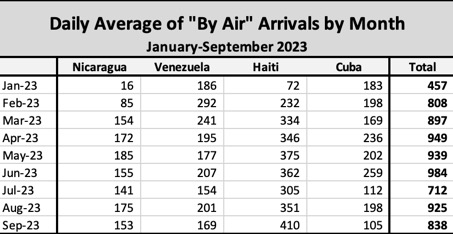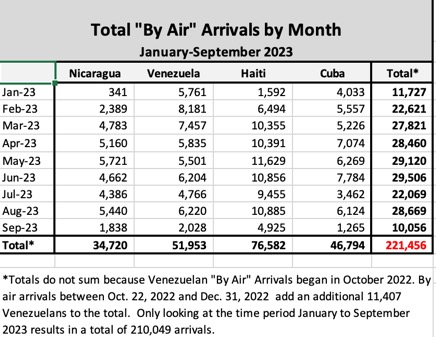Summary: A little-known part of the Biden administration’s CBP One parole program allows inadmissible aliens to make an appointment to fly directly to U.S. domestic airports, bypassing the border entirely. Partial program data, just obtained by the Center for Immigration Studies under a Freedom of Information Act request, reveals that more than 200,000 people in four countries have used this program direct flight and parole within the last year.
In January, President Joe Biden’s Department of Homeland Security began implementing the cornerstone of his current Southwest Border Management Strategy: a series of new “legal pathways” measures designed to decrease the statistics of historically high monthly “encounters” of immigrants who cross illegally and shrink their mass congregations before they become a political issue.
For one of the most publicized measures, DHS seized tens of thousands of people who cross the border illegally with the intention of passing CBP One smartphone app, and rendezvous with US officials at land ports of entry instead of crossing illegally. After making an appointment, DHS invites these inadmissible aliens to walk over to the U.S. side at land ports, where U.S. customs officials quickly “release” them, allowing them to travel to a city of their choice in the interior of the nation.
But one of the lesser-noticed, mysterious and potentially more controversial new re-channeling programs using the CBP One app allows migrants to board commercial passenger flights from foreign countries directly to American cities of their choice, overflying the border, and even in Mexico For this measure, Cubans, Venezuelans, Nicaraguans, Haitiansi Colombians — while still in countries south of Mexico — apply for “advance travel authorizations.” the same CBP One mobile app and take commercial flights (“at their own expense”) directly to U.S. airports, where they are paroled into the nation by U.S. Customs agents, unseen and in publicly unknown numbers.
Biden officials have rarely, if ever, discussed this “family reunification” flight program in the year since they implemented it, perhaps considering the political cry for nocturnal “ghost flights”. that DHS secretly arranges for the transportation of migrant children to various airports, and considering, also, recent political reaction in large American cities such as New York and Chicago to parole migrants who enter by bus from the border. Here, migrants flying directly to America go unaccounted for in monthly Border Patrol records, go unnoticed, and without media consultation, virtually all information about them is almost hermetically sealed.
But records obtained by the Center for Immigration Studies as part of ongoing Freedom of Information Act (FOIA) litigation against US Customs and Border Protection (CBP) show that these migrant flights have brought a significant number of migrants in US cities for most of the past year. (See Excel files for “Parole Arrivals”. cuba, Haiti, Nicaraguai Venezuela.)
Records show that between late October 2022 and mid-September 2023, the administration approved a total of 221,456 Venezuelans, Haitians, Cubans and Nicaraguans for “mode of travel: air” at U.S. domestic ports yet not specified
Government policy requires migrants “approved to travel” to pay for their own tickets: “If approved, the beneficiary is responsible for securing their own travel by commercial aircraft to an inland POE. [port of entry],” according to the typical language to the corresponding notices of the Federal Register.
The Biden administration did not release the numbers or the receiving airports for the Colombians or approved Ukrainians use the direct flight parole program, which anticipates a much higher total number cleared to fly. More recently, the added administration Hondurans, Salvadorans and Guatemalans in the direct flight family reunification program, and their number also remains unknown.
However, the four nationalities for which data were released likely represent the lion’s share of the total that flew in the past year and provide a rare early window into the magnitude of the program.
Data that has been released for the four nationalities shows that these hundreds of thousands of migrants used between 35 and 43 inland ports of entry, meaning airports with US customs agents who do the work of letting those on parole in the United States.
But so far, CBP has canceled and withheld the locations of the 43 inland ports of entry that have been used by this direct flight and parole program, saying their release would impair enforcement techniques or procedures. the law
The administration has been reluctant to provide meaningful data on its sweeping border strategy based on CBP One, which it touts as its central solution to mitigating unsightly surges of migrants at the southern border by using the interface in line to handle mass paroles of inadmissible aliens who would otherwise cross illegally.
Since announcing and implementing this direct flight parole program in October 2022 for Venezuelans and in January for Cubans, Nicaraguans, Haitians and Colombians, the administration has prevented at least one congressional investigation (led by Rep. Tom Tiffany of Wisconsin) for the numbers. Similarly, the Center for Immigration Studies, which filed a FOIA request for the relevant data in March 2023, was forced to sue CBP in order to obtain the records in a timely manner.
The administration has also sought to limit the release of data on the better-known parole program through the CBP One citation application at physical land ports with Mexico (which the administration largely attributes to the brief reduction in illegal crossings at the border) and has not yet provided the total figures throughout its existence, as of mid-2021.
Airports without a name
In response to CIS’s FOIA request regarding the Direct Flight and Parole Program, CBP has redacted and withheld the locations of U.S. domestic ports of entry to which migrant applicants fly after enter your biometrics and other information to DHS through CBP. a system City leaders and residents would certainly like to know how much they want in their cities for planning, funding and public input purposes, at a minimum.
 |
 |
In correspondence with CIS, CBP attorneys justified their redactions under FOIA Exception 7(E), which generally protects law enforcement. “Techniques and procedures…in the context of a police investigation or prosecution” when its public disclosure would cause “foreseeable harm”.
CBP has yet to fully articulate its reasoning for its use of the 7(E) exemption, as required by law, writing only in a government letter that “CBP has considered the foreseeable harm standard when reviewing the registry established above and has applied the FOIA exemptions as required by statute and the Attorney General’s guidelines.”
Meanwhile, the limited data released on the direct flight and parole program show that of the four nationalities, Haitians flew into US airports in the most numbers from January through mid-September, a total of 76,582. These Haitians favored an airport drafted over the 36 they have flown to. About 47,768 flew into this airport. Another of the main receiving airports occupied 13,155, and still 12,833 more.
The program was offered to Venezuelans a few months earlier, in October 2022. Since then, 63,360 flew to 43 airports, about 39,474 of them to a preferred airport.
Some 46,794 Cubans flew to 41 airports, the majority of them, 33,355, favoring one in particular.
(It’s likely that the airport of choice in all of these cases was Miami, but we won’t know for sure unless CBP provides the unredacted information.)
More than 24,000 of the 34,720 Nicaraguans who flew to 35 different airports went to just two of them.
With the missing numbers
To better understand the full extent of the historic mass immigration crisis now entering its third year, the American public should see more than just the numbers of people crossing illegally. between ports of entry, but also those being run through the administration’s new “legal channels,” which the administration has heavily advertised to the US public and migrants as being handled to varying degrees through interfaces of the CBP One system.
Such a full understanding would require public knowledge of how many others, beyond those who crossed illegally and were paroled in and out of the designated management system, entered the United States after their appointments for the CBP One application at physical land ports and too those permitted to fly from foreign countries directly to US airports for “family reunification parole” release. Those who want to must also enter biometrics and other personal information into the CBP One portal.
Until these numbers are revealed, public and private institutions will not have the information they need to prepare for the full influx.
But the administration has withheld full data from both programs.
For example, the American public is probably most familiar with the CBP One citation program implemented for land ports in early 2023, primarily for Nicaraguans, Cubans, Haitians, and Venezuelans.
But this program started almost two years earlier and has benefited all nationalities, not just these four.
The CIS FOIA lawsuit demands a breakdown by number and nationality of all migrants invited to land ports by the CBP One citation who was later paroled into the country, dating back to the first iterations of the program in 2021.
CIS first discovered i informed about the interface managed parole program in November 2021, in Reynosa, and that all nationalities without limitation had access long before the administration specifically implemented it for Venezuelans, Nicaraguans, Cubans and Haitians.
A year later, in November 2022, the CIS discovered it and reported it the CBP One managed parole program had been quietly expanded, without much media attention, to a dozen land ports, bringing tens of thousands of migrants a month from Tijuana to Matamoros, Mexico. Among the migrant beneficiaries were mainly Mexicans, but also Central Americans and Africans.
In the months since the administration announced the program for just the four nationalities, CIS has found many other nationalities also using it. Foreigners from Dagestan, Kyrgyzstan, Russia, Belarus, Mexico have been included, as well as many nations in South America, Africa, and even Mexico.

